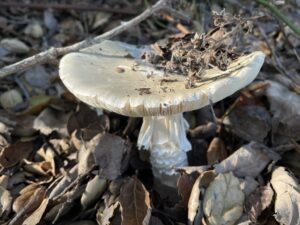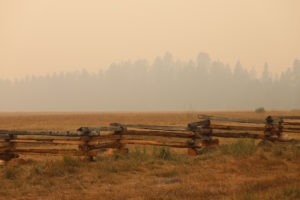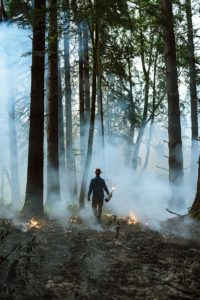Fire dwells deep in the human psyche. It is among the oldest of words, the most elemental of tools, and the primary means by which early man projected himself onto the world. The torch and the hearth fire enabled our move from the cave to the village, while broadcast burning gave us the ability to shape the environment to fit our needs, rather than merely adapting to the existing landscape.
The Coast Miwok lived along the coast of Marin at least 5,000 years before the arrival of Europeans. While more is known about the practices of the related inland Miwok of the Sierra foothills, the Coast Miwok most certainly managed their environment in part by regularly burning it. They learned through observation of nature that a landscape in the early stages of succession after a fire produced their primary foods in greater quantity and better quality. Thus the bounty of this region existed not despite human presence, but rather (to a certain degree) because of it.
According to Carlos Porrata, former ranger at Tomales Bay State Park, the Miwok would allow the season’s first crop of acorns—which was often infested with worms—to drop uncollected. They would then light fires under the oaks; the subsequent acorn crop would be prolific and worm-free. After a fire, stump-sprouting trees, understory shrubs, and new grasses would attract elk, deer, and other game that preferred the new shoots of secondary growth to the woody stems of the old forest. Of course, an open understory also made it easier for hunters to see their prey.
The Miwok also lit periodic fires in the grasslands after they had collected the seeds of wild rye, madia, wyethia, lupine, and red maids, which they made into seedcakes called pinole. By scorching the sun-dried bunchgrasses in fall, the Miwok removed old thatch and encouraged healthy new growth and a heavy inflorescence (thus more seeds) the following year. Tasty edible bulbs like camas, soap root, blue dicks, and Brodiaea all proliferate after a burn. Fires also kept coyote brush, sagebrush, and other pioneer shrubs of the coastal scrub in check. And, by burning up to the edge of the forest, the Miwok created the illusion of a fence that elk and pronghorn were hesitant to cross, a technique for “tending” wild herds.
According to a Miwok chief, “Burning was limited to certain elders who were looked up to as leaders or who understood how fire should be handled.” This show of respect for fire’s elemental importance underscores the Miwok’s acknowledgment of the associated dangers. They lacked hydrants, hoses, and the other tools of a modern fire department; a fire out of control could easily mean the loss of a village. The Miwok’s regular maintenance burns not only rejuvenated the landscape but also prevented the buildup of fuels that could lead to a catastrophic wild fire.
The arrival of the colonial powers from Spain brought major changes in the fire regime. In 1793, Governor Arrillaga outlawed all deliberate fires set by Indians in California, citing “widespread damage which results to the public from the burning of fields.” We do not know whether this negative assessment derived from a fear of grass fires spreading into towns, a misunderstanding of natural fire dynamics, or simple racism. But without a doubt, the Spanish edict altered cycles of fire ecology that had previously turned in harmony with mankind. Native grasslands began to degrade as scrub vegetation took over and fuel levels rose in the forests, compounding the risk of uncontrollable wildfires.
The Spanish Crown eventually yielded California to Mexico, and fire policy was revised to allow Mexican ranchers to burn coastal scrub as a means of opening up new lands for cattle. These regions were then grazed to the ground and left fallow as the cattle were driven to their next pasture, a high-shock and low-value transaction.
- One of the 45 homes in Paradise Ranch Estates on Drakes View Drive that burned down in the Vision Fire. Photo by Richard Blair.
When the United States took California from Mexico in 1848, fire policy became an instrument of the logging industry, which operated under the principle of “preservation of capital.” Trees are lumber and lumber is money, so total fire suppression was the rule. In the 1940s, the National Park Service began doing controlled burns in the Florida Everglades, the first official recognition of fire as a positive factor in promoting viable plant and animal communities. Still, it took another two decades for prescribed fire to be embraced agency-wide as a means of ecological management and restoration.
Meanwhile, human settlements expanded rapidly in the 20th century (the suburban boom of the 1950s, the “back-to-the-land movement” of the 1970s, and the sprawl of the 1990s), resulting in a sharp increase of the number of people living at the wildland-urban interface (WUI). Research by the U.S. Forest Service in 2000 found that California had 5 million homes on the WUI, more than any other state and twice as many as second place Pennsylvania.
This reality presents an ongoing challenge to fire officials. At Point Reyes, as in other national parks with nearby towns, the 2004 fire management policy calls for suppression of any “unplanned ignition.” Even prescribed burns, conducted here on a limited scale, may not burn freely within their perimeters throughout the night, but must be extinguished by the end of the day they are set. This denies fire its elemental role as unregulated destroyer and creator, but it defers to the imperatives of the contemporary world, where human life and property must be protected. A major blaze like the Vision Fire is no longer just a harmonious (if dramatic) element of the landscape. It’s an emergency.
The bulk of fire-related work today along the WUI at Point Reyes focuses on mechanical fuel reduction, on both the landscape and personal scales. For the former, “shaded fire breaks” (i.e., stands of trees that have been thinned rather than clear-cut) can slow the spread of wildfires and keep them at a lower intensity until they can be contained; the current fire policy authorizes up to 1,500 acres of mechanical fuel reduction each year. For the latter, the clearance of trees, brush, and tall grass at least 30 feet around homes and other buildings creates a localized buffer of “defensible space” that can slow the spread of fire in developed areas. In the last four years, the NPS (working with the local nonprofit FIRESafe Marin) has distributed $1.7 million in grants for fuel reduction work along the WUI, most of it focused on private property. “In the event of a wildland fire,” says Wendy Poinsot, environmental planner for the NPS fire program in the Bay Area, “no amount of fuel reduction on federal lands can compensate for the hazards of high fuel loads immediately surrounding homes on private lots.’To this end, the Marin County Open Space District allows private land owners to mow grass into public land up to 30 feet from shared boundaries. Officials can’t do it all (they just don’t have the budget), so they encourage local residents to help out.
Since the Vision Fire, officials at Point Reyes have taken steps to inform future firefighting efforts by collecting data on the specific location of major water resources, endangered plant communities, and listed animal species. When a wildfire occurs that does not threaten life or property, NPS policy calls for suppression methods that minimize resource damage. The park now has resource experts on staff to help the lead responding fire agency develop or adapt strategies that avoid undue incidental harm.
But how can we reconcile the subdivision and the forest? Paradise Ranch Estates, where all the houses were lost in the Vision Fire, was swiftly rebuilt even as young bishop pines rose up all around and throughout its properties. These young pines are flammable; they will grow old within our lifetimes, and require a fire of their own to produce heirs.
“You get a short-term response from the public,” says Kent Julin, president of FIRESafe Marin. “We have these fires—the Oakland hills, the Vision Fire—but within a few years, people just forget and move on.” His organization works to reduce or eliminate fire hazards and to promote fire safety education, but the contradictions of human habitation in a fire-prone ecosystem cannot always be resolved. “It’s definitely a challenge to balance the needs of people and ecology,” he admits.
The photographer Richard Blair, who lost a cabin to the Vision Fire, offers a wry hypothesis that, along with house sprinklers and 30-foot brush-free zones, insurance may be the latest human adaptation to fire. “If you want to live in a fire zone,” he says, “and every 50 years you—re willing to take a settlement from the insurance company and rebuild—well, that’s one way to handle it.”
Blair recalls watching the fire that consumed his neighborhood, and describes his unexpected feelings of hope and expectation. “I sensed that something good would come of it,” he says. “Even as my house was burning down, I was struck by the sheer beauty and majesty of the event.”
Such are the paradoxes along the wildland-urban interface, where our desire to commune with Nature confronts its fierce and ancient mandates, contributing yet another chapter to the ongoing saga of people and wildland fire.

.jpg)




